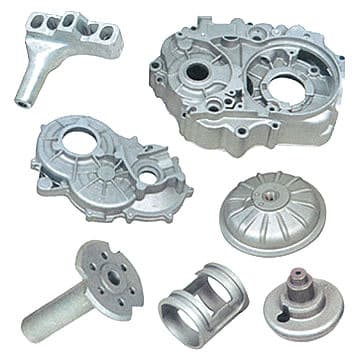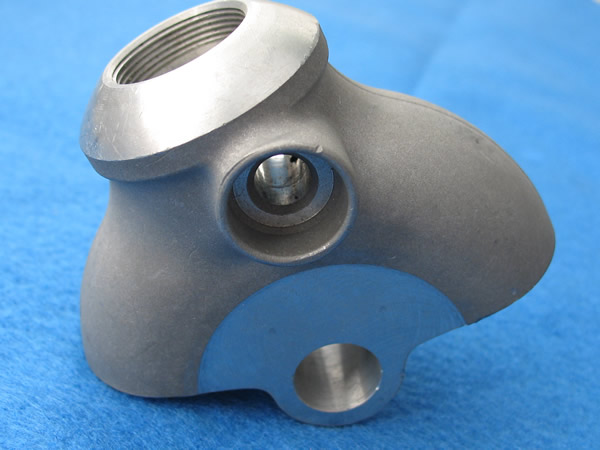Proven strategies for improving Aluminum Castings quality
The Function of Aluminum Casting beforehand Lasting Production Practices
Aluminum casting acts as an important component in promoting sustainable manufacturing methods. Its ability to create top notch elements with a decreased ecological impact is exceptional. The procedure not just supports energy effectiveness yet likewise considerably enhances recyclability. Nevertheless, obstacles remain in totally realizing its potential. Discovering the technologies in aluminum casting technology could reveal options that straighten manufacturing with sustainability goals. The implications of these developments deserve considering.
Understanding Aluminum Casting and Its Refine
Aluminum casting has actually been a basic process in producing for decades, its relevance proceeds to expand in different industries due to its convenience and effectiveness. This procedure involves pouring molten aluminum right into molds to produce detailed shapes and components, making it optimal for creating light-weight yet durable products. The aluminum casting procedure can be categorized into numerous techniques, consisting of sand casting, pass away casting, and investment casting, each offering special advantages suited to certain applications.
Throughout the casting procedure, aluminum is heated up to its melting point, allowing it to flow quickly into mold and mildews that define the last form. As soon as cooled down, the aluminum strengthens, causing a solid and precise component. The ability to produce complex geometries with very little waste highlights aluminum casting's function in modern manufacturing - Aluminum Castings. As industries look for ingenious solutions, comprehending this procedure ends up being necessary for enhancing production and meeting the demands of a developing market
Environmental Advantages of Aluminum Casting
As markets increasingly focus on sustainability, the ecological advantages of aluminum casting end up being much more pronounced. One substantial benefit is the material's recyclability; aluminum can be reused consistently without degrading its top quality. This minimizes the quantity of waste sent to landfills and minimizes the requirement for virgin products, conserving natural deposits. In addition, the aluminum casting process produces fewer greenhouse gas discharges contrasted to other metal casting methods, adding to reduced total ecological influence.
Another benefit depends on the lightweight nature of aluminum, which results in sustain efficiency in transportation applications. By making use of aluminum components, producers can reduce automobile weight, resulting in reduced fuel usage and emissions throughout operation. Furthermore, developments in aluminum casting innovations have resulted in a reduction in contaminated materials production, improving total ecological safety. Jointly, these variables placement aluminum casting as a crucial player in promoting lasting manufacturing practices and meeting environmental objectives across various sectors.
Power Efficiency in Aluminum Production
Power efficiency plays an important role in aluminum production, markedly influencing general sustainability. By adopting cutting-edge casting techniques and incorporating sustainable energy resources, producers can achieve minimized energy intake throughout the production procedure. This shift not just lowers functional costs yet also adds to a more eco-friendly sector.

Lowered Power Usage
While the aluminum manufacturing industry has actually generally been energy-intensive, recent developments have actually substantially enhanced energy efficiency throughout the manufacturing process. Developments in smelting technology and the fostering of high-efficiency heating systems have actually substantially minimized power usage. These enhancements enable manufacturers to make use of less power each of output, decreasing greenhouse gas discharges and decreasing operational costs. In addition, the integration of eco-friendly energy resources right into manufacturing facilities further adds to reduced dependence on fossil fuels, advertising sustainability. Executing innovative insulation materials and optimizing warmth recovery systems additionally plays an important duty in making best use of energy performance. As a result, the aluminum sector is making significant strides towards lowering its overall ecological impact while meeting the boosting need for sustainable methods in production.
Innovative Casting Methods
Cutting-edge casting techniques are transforming the aluminum manufacturing landscape, boosting both efficiency and sustainability. Advanced techniques such as die casting and financial investment casting minimize material waste and enhance dimensional precision, leading to minimized power usage throughout the manufacturing procedure. Techniques like rapid solidification and semi-solid processing permit far better control over metallurgical buildings, resulting in lightweight and high-strength elements. Additionally, the application of computer system simulations and automation in casting processes optimizes cycle times and minimizes issue rates. These technologies not just simplify manufacturing but also add to the circular economic climate by allowing the recycling of aluminum scrap into top notch items. As an outcome, the aluminum sector is positioned to fulfill expanding needs while adhering to sustainable production methods.
Renewable Resource Combination
A significant change towards sustainable energy integration is reshaping power performance in aluminum production. This adjustment entails using solar, wind, and hydropower sources to decrease reliance on nonrenewable fuel sources, significantly lowering carbon emissions. Facilities are significantly taking on energy-efficient innovations, such as sophisticated electrolytic processes, which maximize power usage during aluminum manufacturing. By using sustainable energy, producers not only lower functional costs but additionally boost their sustainability profiles. Additionally, clever grid innovations assist in the seamless assimilation of eco-friendly sources, permitting even more steady energy products. As the market embraces these developments, the aluminum field is placed to lead in sustainable techniques, demonstrating a dedication to environmental stewardship while fulfilling boosting worldwide need for lightweight, high-performance products.
The Recyclability of Aluminum and Its Impact
Aluminum's recyclability provides considerable advantages in lasting manufacturing, enabling unlimited recycling without loss of quality. This home not only minimizes waste but additionally enhances power effectiveness throughout the recycling procedure. As an outcome, the effect on both the setting and manufacturing expenses is extensive, making aluminum a preferred material in eco-conscious industries.
Infinite Recycling Potential
Several materials lose high quality via reusing processes, aluminum stands out due to its unlimited recyclability, which considerably adds to sustainable manufacturing methods. This one-of-a-kind characteristic allows aluminum to be recycled continuously without weakening its residential properties, making it a beneficial resource in various markets. The lifecycle of aluminum starts anew with each recycling effort, conserving raw materials and decreasing waste. This not only lessens the ecological influence yet additionally cultivates a circular economic situation where aluminum can be recycled numerous times. The high need for recycled aluminum additionally stresses its relevance in lasting production, as it improves source effectiveness and promotes an eco-friendly approach to manufacturing. Inevitably, the boundless reusing capacity of aluminum plays a considerable role ahead of time sustainable techniques throughout markets.

Energy Effectiveness Conveniences
Significant energy savings are recognized with the recycling of aluminum, highlighting its function in lasting production. Reusing aluminum calls for just 5% of the power required to generate new aluminum from raw materials. This significant decrease in energy usage equates right into reduced greenhouse gas discharges, adding to ecological sustainability. The power effectiveness of aluminum reusing not just saves sources yet additionally reduces functional prices for suppliers, making it a financially sensible alternative. In addition, the procedure of reusing aluminum this link can be integrated right into existing assembly line without substantial disturbance, improving general effectiveness. As industries increasingly focus on sustainability, the recyclability of aluminum placements it as a principal in advancing energy-efficient manufacturing techniques, cultivating a circular economic climate and promoting responsible source administration.
Challenges Dealing With Aluminum Casting in Lasting Practices
While the aluminum casting industry has made strides in the direction of lasting methods, several challenges continue to be that prevent its development. One significant concern is the high energy consumption connected with standard casting methods, which frequently relies upon nonrenewable fuel sources. This dependence not just raises functional costs yet also adds to greenhouse gas discharges. Additionally, the reusing process for aluminum can be ineffective, resulting in worldly loss and increased waste. One more challenge is the restricted availability of sustainable basic materials, as sourcing recycled aluminum can be tough and costly. Regulatory pressures and differing ecological requirements throughout regions make complex compliance efforts, making it testing for firms to adopt uniform lasting practices. Labor force training continues to be insufficient, with several employees lacking the required abilities to apply cutting-edge, environmentally friendly methods in casting procedures. Addressing these challenges is essential for the aluminum casting market to completely recognize its possibility in lasting production.
Innovations in Aluminum Casting Innovation
To conquer the difficulties dealt with in lasting methods, the aluminum casting industry is seeing a wave of developments focused on improving effectiveness and minimizing ecological effect. Advanced casting techniques, such as 3D printing and die casting, are being embraced to lessen material waste and improve precision. These technologies enable producers to create complex geometries with less aluminum, thereby preserving sources.
Furthermore, the combination of recycling methods, consisting of closed-loop systems, facilitates making use of scrap aluminum, significantly minimizing energy consumption contrasted to main aluminum production. Enhanced mold and mildew designs and finishings are also adding to sustainability by enhancing thermal effectiveness and reducing exhausts throughout the casting process.
Automation and smart production technologies are being applied to enhance manufacturing processes, resulting in reduced cycle times and power usage. Jointly, these innovations stand for a considerable change towards more lasting techniques within the aluminum casting market, aligning with more comprehensive environmental objectives.
Future Potential Customers for Sustainable Production With Aluminum Casting
As the need for lasting manufacturing practices heightens, the aluminum casting sector is positioned to play a crucial role fit a greener future. The field is progressively taking on reusing processes that considerably decrease waste and energy usage, lining up with worldwide sustainability goals. Advancements such as low-energy casting methods and using recycled aluminum not just lessen carbon impacts however likewise improve the general effectiveness of production.

As markets look for to follow more stringent ecological guidelines, the aluminum casting market stands all set to give lasting options, placing itself as a principal in the change towards environment-friendly manufacturing methods in various industries, including automotive and aerospace.
Frequently Asked Questions
How Does Aluminum Casting Compare to Other Steel Casting Approaches?
Aluminum casting typically provides benefits such as reduced melting points and exceptional recyclability compared to various other steel casting techniques. Its lightweight nature and excellent deterioration resistance better improve its charm in various production applications.
What Industries Advantage A Lot Of From Aluminum Casting?
Different industries, consisting of vehicle, aerospace, and consumer goods, substantially advantage from aluminum casting - Aluminum Castings. This method's light-weight, corrosion-resistant residential or commercial properties enhance product performance while allowing for intricate styles, making it an appealing choice for producers seeking effectiveness and technology
Can Aluminum Casting Be Made Use Of for Complicated Layouts?
Aluminum casting can properly accommodate intricate styles because of its versatility and capacity to form detailed shapes. This procedure allows suppliers to produce light-weight, resilient parts suitable for different applications throughout different markets, enhancing advancement and efficiency.
What Is the Life Expectancy of Aluminum Cast Products?
The life-span of aluminum navigate to this website cast items typically ranges try this site from numerous decades to over a century, depending upon elements such as environmental problems, upkeep, and the details application. Resilience makes them ideal for various long-lasting usages.
How Does Aluminum Casting Effect Task Production in Manufacturing?
Aluminum casting significantly adds to task development in production by fostering proficient labor possibilities, supporting local economic climates, and motivating technological improvements. This procedure not just enhances production efficiency however likewise advertises labor force advancement and training efforts.